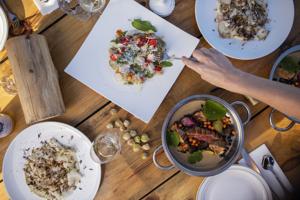“You’re lucky your first time is in Charlevoix,” says pilot Arnaud Laboisse of . It was the start of my trip to Charlevoix, a region that begins just over an hour’s drive from Quebec City, and I was taking my first helicopter ride for a bird’s-eye view of the crater left by the meteor that created this region 350 million years ago. Laboisse pointed out the 54-kilometre-wide crater’s centre, called Les Éboulements, as we soared over the rolling riverside hills that make up a flavour trail of rich terroir.
Established in 1996, Charlevoix’s Flavour Trail will have you going around in circles. There is no set route for this culinary adventure but rather a map of more than 30 agri-tourism businesses. And this summer, as I spent four days sipping, slurping and otherwise savouring this special stretch of Quebec along the St.

Lawrence River, I discovered how exclusive these products are: Most can only be found within the region. And many producers have no ambitions to sell beyond Charlevoix. The landscape of Quebec’s Charlevoix region.
Also notable is the collaborative nature of the region’s producers — a detail I noticed as I tucked into a hotel dish featuring potatoes with (I had tried the cheese at the family fromagerie the day before), and as I sampled some local mead (I strolled past the beehives that produced the honey that same day). And with every bite or drink, I could taste a dedication to quality over quantity as distinctly as the flavours. When I arrived at the bustling in Baie-Saint-Paul, I found a line of diners waiting for a table — a line that didn’t seem to shorten as I enjoyed a patio meal with Frédérick Tremblay and Caroline Bandulet, owners of the pub.
The pair founded MicroBrasserie Charlevoix in 1998 by introducing the community to strong Belgian beers and serving pub favourites with a local focus. My burger is piled high with boar from Les Volières de Baie-Saint-Paul, bacon from Charcuteries Charlevoisienne, and cheese from Laiterie Charlevoix — all skewered in place with a fried pickle. Tremblay told me the beef in their burgers come from the cows of Ferme la marre, just down the road, which are fed the leftover spelt from their beer making.
Throughout my trip, I saw this reciprocity among producers repeatedly. The aromatic flowers I found at , for example, later showed up in the haskap jam I sampled at the Lupin Fruit orchard. And the flour milled at the 19th-century was the kind I saw stocked at roadside farm stands in Les Éboulements.
The refining house at Famille Migneron, where artisanal cheeses are made from local ingredients. Fromagerie signs guided me down a long driveway to ’s farm, and as I walked into the tasting room, co-owner Madeleine Dufour uncorked the latest bottle of Charlevoyou rosé, which had landed on shelves just that day. We sipped the funky vintage and nibbled sheep’s milk cheese as she recounted her family’s cheesemaking history, which dates to 1996.
The locavore-focused family started producing wines in the mid-2010s, and their inventive whey spirit, Eau-de-Vie de Petit Lait, in 2020. They make the spirit with leftover whey from the fromagerie, using an ingredient that would otherwise go to waste. “It proves that taking care of your byproducts can be fun and delicious,” says Dufour.
This summer, Charlevoyou’s rosé and blanc wines come in cans, but like their other products, you’ll have to visit the farm to buy them. Ninety-five per cent of Famille Migneron’s products are sold from their tasting room, a practice that preserves local production and consumption. My next stop took me to the mead maker , where co-owner Alexandre Côté met me at her starkly modern tasting room in Baie-Saint-Paul, tucked behind rue St-Jean-Baptiste’s restaurants and art galleries.
Côté toured me around the production area, which opened in 2021, where they craft honey wines and spirits. While they’re based in town, their 485 beehives are spread across 20 different sites, mostly private businesses “from to .” “We harvest very different honeys depending on the apiary location,” explains Côté, “Charlevoix has a unique terroir, possibly due in part to the meteorite crater, between mountains, valleys and the river, which creates different habitats for a large variety of flowers.
” This gives the different flavours for each libation they produce. I also sampled their newest gin, Baie Sauvage, which is flavoured with different wild fruits from Charlevoix. You’ll have to visit in person for the experience, although they ship some products online, and select Hydromel products are sold in regional boutiques.
On my last day in Charlevoix, I visited , where a farrow of Berkshire pigs was nursing as Gabrielle Cadieux-Gagnon showed me around. The family farm in Les Éboulements is credited with helping Charlevoix achieve its protected geographical indication (PGI) designation for lamb, cementing its standard of quality regionwide (and its appearance on high-end restaurant menus). This summer, the farm’s boutique evolved into a restaurant, called Épicentre Dînette Fermière, to help maximize the ingredients the butchery is producing.
Think: ewe labneh with fresh pita, merguez sausage in a roll and farm-made charcuterie. What hasn’t changed, though, is Cadieux-Gagnon’s focus on Charlevoix: Although she took over the family business in 2018, there are no plans to grow beyond selling their heritage lamb and other products to the local community out of the farm stand and boutique. “I want to stay authentic and not lose the essence of what makes people like our business,” says Cadieux-Gagnon, explaining that she wants to keep in contact with visitors who choose to come here on vacation.
I found the culmination of the Flavour Trail’s exclusive ingredients and local collaboration at , the restaurant on the Famille Migneron estate. Here, chef-owners Émile Tremblay and Sylvain Dervieux serve an ever-changing seven-course dinner to a small group six evenings a week. Apéro started on the patio at 7 p.
m. sharp: cocktails with an amuse-bouche of beef tongue tartare perched on a rock. Afterwards, we moved inside, and at the ring of the dinner bell, Dervieux described each course.
He explained that more than 80 per cent of their ingredients are sourced within Charlevoix, and many of the producers I had visited appeared on the plates, which this evening included salmon mousse with blue potato and marigold, and Arctic char escabeche with melon emulsion. Heading back to my hotel that night, I thought about just how unique Charlevoix’s Flavour Trail is. It’s not some tourism gimmick to attract visitors but a veritable how-to guide on sustainability and quality control for culinary producers (and foodies).
From the squeakiest cheese curds to the sweetest honey wine, Charlevoix has so much deliciousness to offer, for anyone willing to make the journey. Charlevoix starts just over an hour’s drive east from Quebec City. Besides road tripping along the region, which stretches along the St.
Lawrence River, travellers can also take the between the main towns. is a family-friendly resort in Baie-Saint-Paul, complete with a Nordic spa, two restaurants, and an on-site farm with lush rows of garden veg, llamas and highland cows. To plot your own way through Charlevoix’s Flavour Trail, visit , which lists agri-tourism stops from Petite-Rivière-Saint-François to La Malbaie.
.



















